Helen Allingham
| Helen Allingham | |
|---|---|
 Helen Allingham in 1903 | |
| Born |
Helen Mary Elizabeth Paterson 26 September 1848 Swadlincote, Derbyshire, England |
| Died |
28 September 1926 Haslemere, Surrey, England |
| Nationality | British |
| Other names | H. Paterson |
| Occupation | illustrator and watercolour artist |
| Spouse(s) | William Allingham (1874–1889) |
| Website | Helen Allingham society |
Helen Allingham RWS (née Paterson; 26 September 1848 – 28 September 1926) was an English watercolourist and illustrator of the Victorian era.
Biography
Helen Mary Elizabeth Paterson was born on 26 September 1848, at Swadlincote in Derbyshire, the daughter of Alexander Henry Paterson, a medical doctor, and Mary Herford Paterson. Helen Paterson was the eldest of seven children. The family moved to Altrincham in Cheshire when she was one year old. In 1862 her father and her three-year-old sister Isabel died of diphtheria during an epidemic. The family then moved to Birmingham, where some of Alexander Paterson's family lived.[1]
Paterson showed a talent for art from an early age, drawing some of her inspiration from her maternal grandmother Sarah Smith Herford and aunt Laura Herford, both accomplished artists of their day. Her younger sister Caroline Paterson also became a noted artist. She initially studied art for three years at the Birmingham School of Design (founded 1843). She spent a year at the Royal Female School of Art in London, before following her aunt Laura Herford to the National Art Training School, one of the Royal Academy Schools, which would later become the Royal College of Art.[2] In the early stage of her life, Helen was very interested and talented in drawing things. She was inspired by her grandmother, known as Sarah Smith Herford, and her aunt Laura Herford. Although her father died when she was thirteen, Helen continued to grow and express her desires for art. In 1867, she was enrolled in Royal Academy School. She used to sketch figures in black and white colors to sell for money to pay for her expenses. After that, her work sometimes appeared in children’s books. Later on, she was very popular for her artworks. She was an watercolourist and illustrator.
Career
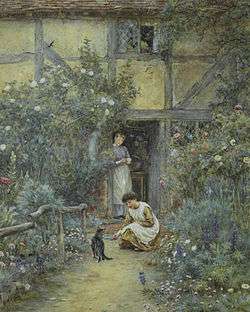
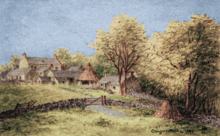
While studying at the National Art Training School, Paterson worked as an illustrator, eventually deciding to give up her studies in favour of a full-time career in art. She painted for children's[3] and adult books, as well as for periodicals, including The Graphic newspaper. One highlight was her commission to provide twelve illustrations for the 1874 serialisation of Thomas Hardy's novel Far from the Madding Crowd in Cornhill Magazine.[4] Her illustrations from this era were signed either "H. Paterson" or "H. Allingham".[5] She became a lifelong friend of Kate Greenaway whom she met at evening art classes at the Slade School of Fine Art.
While Vincent Van Gogh was developing as an artist by studying English illustrated journals he was struck by Paterson's work in The Graphic. Although females could not gain the same recognition as men at this point in history, it shows that women made a massive impact in art for centuries as artists like Van Gogh needed influences such as her works in order to grow into the artist he became.[6][7]
On 22 August 1874 she married William Allingham, Irish poet and editor of Fraser's Magazine, who was almost twice her age. After her marriage she gave up her career as an illustrator and turned to watercolour painting. In 1881 the family moved from Chelsea to Witley in Surrey. Her first son was born in November 1875 and was named Gerald Carlyle. Her daughter was born on 21 February 1877 and her last son on 11 May 1882. Helen started to paint the beautiful countryside around her and particularly the picturesque farmhouses and cottages of Surrey and Sussex for which she became famous. To her critics, however, despite elements of protest in 'The Condemned Cottage' for example, hers was an overly sentimental, conservative vision of the area.[8] She went on to paint rural scenes in other parts of the country – Middlesex, Kent, the Isle of Wight and the West Country – and abroad in Venice, Italy. As well as landscapes, she completed several portraits, including one of Thomas Carlyle. In 1890, she became the first woman to be admitted as a full member of the Royal Watercolour Society. Allingham exhibited her work at the Palace of Fine Arts at the 1893 World's Columbian Exposition in Chicago, Illinois.[9]
Legacy
The Helen Allingham Society was founded in 2000.[10] Her time in Altrincham is commemorated by blue plaques at 16 Market Street, Altrincham and at Levenhurst, St. John's Road, Bowdon.[11]
Burgh House, Hampstead, has the world's largest archive and collection of her work.[12]
Paintings
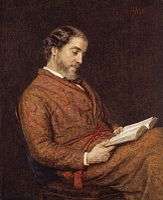 William Allingham 1876
William Allingham 1876 Irish Cottage
Irish Cottage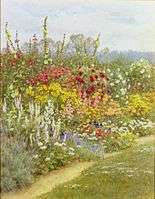 A Herbaceous Border
A Herbaceous Border Harvest Moon
Harvest Moon A Cottage With Sunflowers At Peaslake
A Cottage With Sunflowers At Peaslake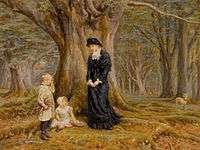 The Lady of the Manor
The Lady of the Manor Morning at the Quay in Venice
Morning at the Quay in Venice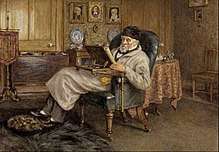 Thomas Carlyle, historian and essayist (1795–1881)
Thomas Carlyle, historian and essayist (1795–1881)
Bibliography
- Illustrated by Helen Allingham
- Huish, Marcus B. (1903). Happy England as Painted by Helen Allingham, R.W.S. Adam & Charles Black. OCLC 9062256.
- Paterson, Arthur Henry (1905). The homes of Tennyson (Adam & Charles Black). Paterson was Helen Allingham's brother.
- Written by Helen Allingham
- Seedtime and reaping (Samuel Tinsley, 1877).
See also
- Walter Tyndale (1855–1943), influenced by Allingham and also lived in Surrey.
- Myles Birket Foster
Notes
- ↑ "Helen Allingham R.W.S. (1848–1926)". Helen Allingham Society.
- ↑ Devereux, Joanna (2016). The making of women artists in Victorian England: the education and careers of six professionals. Jefferson, North Carolina: McFarland & Co. pp. 110, 162. ISBN 9780786494095. OCLC 948560997.
- ↑ Allingham illustrated Juliana Ewing's Six to Sixteen: a story for girls (1876) and A Flat Iron for a Farthing
- ↑ Allingham, Peter (15 November 2002). "Helen Allingham's Cornhill Magazine illustrations for Hardy's Far From The Madding Crowd (1874)". victorianweb.org.
- ↑ Smith, Lucy Toulmin (May 1892). "Women in Contemporary Art. Mrs. Allingham". Atalanta. 5: 455.
The signature H. Paterson, afterwards so familiar, was seen for the first time in the number for April 16, 1870, ...
- ↑ Van Gogh, Vincent. "To Theo van Gogh. The Hague, Friday, 26 or Saturday, 27 January 1883". The Van Gogh Letters Project. Retrieved 8 March 2014.
- ↑ Van Gogh, Vincent. "To Anthon van Rappard. The Hague, on or about Thursday, 8 February 1883". The Van Gogh Letters Project. Retrieved 8 March 2014.
- ↑ Alison Light, Mrs Woolf and the Servants (2007) p. 102
- ↑ Nichols, K. L. "Women's Art at the World's Columbian Fair & Exposition, Chicago 1893". Retrieved 26 July 2018.
- ↑ The Helen Allingham Society
- ↑ "Biographies of local people". This is Cheshire. Archived from the original on 17 October 2013. Retrieved 11 June 2013.
- ↑ "Museum Collections". Burgh House and Hampstead Museum. Archived from the original on 8 March 2014. Retrieved 8 March 2014.
Further reading
- Helmreich, Anne (2001). "The marketing of Helen Allingham: the English cottage and national identity". In Adams, Steven; Robins, Anna Gruetzner. Gendering landscape art. Rutgers University Press. pp. 45–60. ISBN 0-8135-2974-3. A recent essay on Allingham and her art.
- Lester, Anthony J. (1979). The Exhibited Works of Helen Allingham, 1848–1926. Oxfordshire: Wallingford. OCLC 16494169. See also The Exhibited Works of Helen Allingham, R. W. S., 1848–1926. Wallingford. 1979. OCLC 84054249.
- Taylor, Ina (2000). Helen Allingham's England. Caxton Editions. ISBN 978-1840670875. OCLC 50055173. New edition of Helen Allingham's England : an idyllic view of rural life. Exeter, Devon: Webb & Bower. 1990. ISBN 9780863503962. OCLC 26721725. Taylor's recent biography of Allingham.
- Watts, Annabel (2002). Helen Allingham's Cottage Homes – Revisited. ISBN 9780952388203. OCLC 228661464. Reproductions of Allingham's paintings of cottages along with contemporary photographs of the same structures.
- Annabel Watts: article & bibliography in Studies in Illustration no.31/32 Winter 2005/Spring 2006 (Imaginative Book Illustration Society at www.bookillustration.org)
External links
| Wikimedia Commons has media related to Helen Allingham. |
- Helen Allingam society
- http://www.helenallingham.com/Helen_Biography.htm
- https://www.art.com/gallery/id--a32829/helen-allingham-posters.htm
- https://www.the-athenaeum.org/art/list.php?m=a&s=tu&aid=1320
- http://www.chrisbeetles.com/artists/allingham-helen-rws-1848-1926.html
- http://www.spacial-anomaly.com/helen-allingham-and-her-cottages/